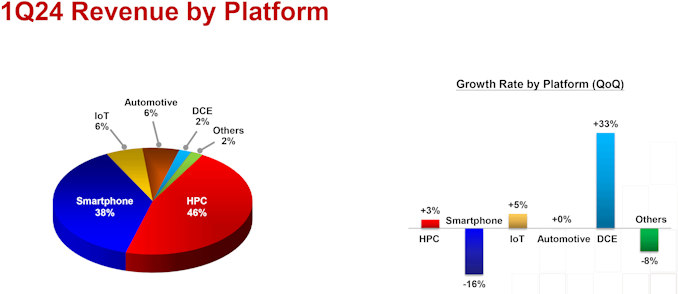TSMC Posts Q1'24 Results: 3nm Revenue Share Drops Steeply, but HPC Share Rises
by Anton Shilov on April 19, 2024 8:00 AM ESTTaiwan Semiconductor Manufacturing Co. this week released its financial results for Q1 2024. Due to a rebound in demand for semiconductors, the company garned $18.87 billion in revenue for the quarter, which is up 12.9% year-over-year, but a decline of 3.8% quarter-over-quarter. The company says that in increase in demand for HPC processors (which includes processors for AI, PCs, and servers) drove its revenue rebound in Q1, but surprisingly, revenue share of TSMC's flagship N3 (3nm-class) process technology declined steeply quarter-over-quarter.
"Our business in the first quarter was impacted by smartphone seasonality, partially offset by continued HPC-related demand," said Wendell Huang, senior VP and chief financial officer of TSMC. "Moving into second quarter 2024, we expect our business to be supported by strong demand for our industry-leading 3nm and 5nm technologies, partially offset by continued smartphone seasonality."
In the first quarter of 2024, N3 wafer sales accounted for 9% of the foundry's revenue, down from 15% in Q4 2023, and up from 6% in Q3 2023. In terms of dollars, TSMC's 3nm production brought in around $1.698 billion, which is lower than $2.943 billion in the previous quarter. Meanwhile, TSMC's other advanced process technologies increased their revenue share: N5 (5 nm-class) accounted for 37% (up from 35%), and N7 (7 nm-class) commanded 19% (up from 17%). Though both remained relatively flat in terms of revenue, at $6.981 billion and $3.585 billion, respectively.
Generally, advanced technology nodes (N7, N5, N3) generated 65% of TSMC's revenue (down 2% from Q4 2023), while the broader category of FinFET-based process technologies contributed 74% to the company's total wafer revenue (down 1% from the previous quarter).
TSMC itself attributes the steep decline of N3's contribution to seasonally lower demand for smartphones in the first quarter as compared to the fourth quarter, which may indeed be the case as demand for iPhones typically slowdowns in Q1. Along those lines, there have also been reports about a drop in demand for the latest iPhones in China.
But even if A17 Pro production volumes are down, Apple remains TSMC's lead customer for N3B, as the fab also produces their M3, M3 Pro, and M3 Max processors on the same node. These SoCs are larger in terms of die sizes and resulting costs, so their contribution to TSMC's revenue should be quite substantial.
"Moving on to revenue contribution by platform. HPC increased 3% quarter-over-quarter to account for 46% of our first quarter revenue," said Huang. "Smartphone decreased 16% to account for 38%. IoT increased 5% to account for 6%. Automotive remained flat and accounted for 6%, and DCE increased 33% to account for 2%."
Meanwhile, as demand for AI and HPC processors will continue to increase in the coming years, TSMC expects its HPC platform to keep increasing its share in its revenue going forward.
"We expect several AI processors to be the strongest driver of our HPC platform growth and the largest contributor in terms of our overall incremental revenue growth in the next several years," said C.C. Wei, chief executive of TSMC.
Source: TSMC












11 Comments
View All Comments
Blastdoor - Friday, April 19, 2024 - link
Does ryzen fall under HPC?ET - Friday, April 19, 2024 - link
I think that pretty much anything that's not in the other categories falls into HPC. This is pretty much all CPU and GPU parts from NVIDIA, Intel, AMD. I'd also guess that Apple and Qualcomm CPUs that aren't for smartphones are classified as HPC.ballsystemlord - Friday, April 19, 2024 - link
This is the first time I've seen a leading process decline, suddenly. Does anyone have an idea as to what the cost of production on the 3nm node is?my_wing - Sunday, April 21, 2024 - link
High, to simplify the matter the is a relationship between EUV layer count and cost (might not be direct relationship but is not that far from this)So N3B is close to 80% more cost to TSMC then N5.
https://fuse.wikichip.org/news/7375/tsmc-n3-and-ch...
BaronMatrix - Monday, April 22, 2024 - link
As the article said smart phones are very seasonal.. Apple, for example makes millions of chips starting in around June or so for the next iPhone in Q4...AMD should have A LOT of products on 3nm right now for release starting Q3...
SanX - Saturday, April 20, 2024 - link
Hey AMD, are you sleeping? We are waiting for Turin 3nm 200-core monstersDante Verizon - Saturday, April 20, 2024 - link
Probably not until next year, when yields improve.my_wing - Sunday, April 21, 2024 - link
Is not Yields, is the clock speed.Same as Intel 4, therefore Meteor Lake is not a desktop part.
my_wing - Sunday, April 21, 2024 - link
No, they are not sleeping, is just only Intel is now awaken. You poke the Godzilla, and now the Godzilla is awaken, much like the K5/6/7 stories back then.TSMC N3B (and possible N3E) from pro AMD source e.g. MLID is that Zen 6 E cores maybe on N3E but P Cores still in N4, this meant that even the 2nd generation N3 Class TSMC is not suitable for HPC/CPU, while Intel 3 is now full steam ahead of the Q3 launch (CPU tile).
BaronMatrix - Monday, April 22, 2024 - link
AMD is very tight-lipped about all of Turin but they surprised everyone with a 16C CCD... IF they can get a 32C CCD in 3nm there will be a 256C EPYC this year...It seems like they may put Ryzen on a 16C CCD, but definitely they will with Threadripper...